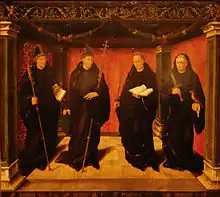Adalbert of Egmond
Saint Adalbert of Egmond (also called Æthelberht of Egmond) (died c. 710 in Egmond) was a Northumbrian Anglo-Saxon missionary. He was one of Saint Willibrord's companions in preaching the gospel in Holland and Frisia.
Saint Adalbert of Egmond | |
|---|---|
 Painting of Saints Bonifatius, Gregorius, Adelbert, and priest Jeroen van Noordwijk, by Jan Joesten van Hillegom, 1530 | |
| Born | Northumbria |
| Died | c. 710 Egmond |
| Venerated in | Anglican Communion Roman Catholic Church Eastern Orthodox Church |
| Canonized | Pre-Congregation |
| Feast | 25 June |
Biography
Adalbert (or Æthelberht) is said to have been born in Northumbria, a member of the Northumbrian royal family.[1] According to some sources, Adalbert studied at the Rath Melsigi) in Ireland with Egbert. Around 690 he went to assist Willibrord[2] (who had also been at Rath Melsigi) in the mission field of Frisia. According to Alcuin's late eighth-century Vita Willibrordi archiepiscopi Traiectensis, they landed near Domburg.[3]
Adelbert became associated particularly with Egmond. He was made Archdeacon of the recently founded See of Utrecht and died at Egmund about A.D. 740.[4] He was buried there, and miracles were reported at his tomb, over which a church was built. Adalbert is said to have shielded the settlement of Egmond from pirates by causing a fog to arise along the coast.[3]
Veneration
His continued remembrance rests largely on the foundation of the Benedictine monastery, Egmond Abbey, the first in the country, some two hundred years later by Count Dirk I of West Frisia (or Holland), of which Adalbert was made the patron. The Vita was not commissioned until the 990s, which presumably accounts for its lack of facts. Adalbert's relics were translated to the newly built abbey (initially a nunnery) for veneration. After the Reformation and the destruction of the abbey, they were preserved in Haarlem. The cult was reinstated when the abbey was re-founded in 1935, and the relics were returned there in 1984. The saint's skull, painstakingly restored, is also preserved beneath the high altar. His feast day is 25 June.[5]
Notes
- "Adelbert". New Catholic Dictionary. CatholicSaints.Info. 6 October 2017
- Lendering, Jonah. "Adalbert van Egmond (†740) – Missionaris in Holland", Historiek, June 25, 2017
- Faber, Hans. "The Abbey of Egmond and the rise of the Gerulfings", Frisia Coast Trail, July 19, 2019
- "Blog Archive » Book of Saints – Adelbert". Saints.SQPN.com. 1 May 2012. Retrieved 24 April 2014.
- Farmer, David. The Oxford Dictionary of Saints, 5th Edition Revised, p. 3, Oxford University Press, 2011 ISBN 9781156973080
References
- Rose, Hugh James (1857). "Adelbert". A New General Biographical Dictionary. Vol. 1 AA–ANS. London: B. Fellowes et al.
External links
- Life of Adalbert, website of Egmond Abbey, in Dutch
- Detailed consideration of the legend and relics of Adelbert, in Dutch
- Attribution
 This article incorporates text from a publication now in the public domain: Stephen, Leslie, ed. (1885). "Adalbert (fl.700)". Dictionary of National Biography. Vol. 1. London: Smith, Elder & Co.
This article incorporates text from a publication now in the public domain: Stephen, Leslie, ed. (1885). "Adalbert (fl.700)". Dictionary of National Biography. Vol. 1. London: Smith, Elder & Co.